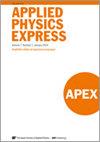量子材料驱动的表面和界面物理学
IF 2.2
4区 物理与天体物理
Q3 PHYSICS, APPLIED
引用次数: 0
摘要
晶体边界(如表面、界面、边缘、铰链、角落和极点)的电子状态在新兴量子材料(如石墨烯和类似的单原子层材料、范德华晶体和拓扑绝缘体)中发挥着至关重要的作用。这些边界上的电子态与三维或二维晶体内部的电子态不同,这不仅是因为晶格的截断,还因为空间反转对称性的打破以及跨越边界的带状结构拓扑结构的不同。由于电子自旋动量锁定、纯自旋电流、无耗散电荷电流、非互惠电流以及可能的马约拉纳费米子等奇异现象,这类量子材料有望推动节能/收集技术以及量子计算/信息技术的发展。在这篇综述中,将从表面物理学的角度介绍它们的基本概念,其中原子和电子结构,以及电荷/自旋传输特性,都是利用最先进的技术直接探测的。本文章由计算机程序翻译,如有差异,请以英文原文为准。
Surface and interface physics driven by quantum materials
Electronic states at the boundaries of crystals, such as surfaces, interfaces, edges, hinges, corners, and extremities, play crucial roles in emerging quantum materials, such as graphene and similar monatomic-layer materials, van der Waals crystals, and topological insulators. Electronic states at such boundaries are different from those inside the three- or two-dimensional crystals, not only because of the truncation of crystal lattices but also because of space-inversion-symmetry breaking and difference in topology in band structures across the boundaries. Such quantum materials are expected to advance energy-saving/-harvesting technology as well as quantum computing/information technology because of exotic phenomena, such as spin–momentum locking of an electron, pure spin current, dissipation-less charge current, nonreciprocal current, and possible Majorana fermions. In this review, their fundamental concepts are introduced from the viewpoint of surface physics, in which atomic and electronic structures, as well as charge/spin transport properties, are directly probed using state-of-the-art techniques.
求助全文
通过发布文献求助,成功后即可免费获取论文全文。
去求助
来源期刊

Applied Physics Express
物理-物理:应用
CiteScore
4.80
自引率
8.70%
发文量
310
审稿时长
1.2 months
期刊介绍:
Applied Physics Express (APEX) is a letters journal devoted solely to rapid dissemination of up-to-date and concise reports on new findings in applied physics. The motto of APEX is high scientific quality and prompt publication. APEX is a sister journal of the Japanese Journal of Applied Physics (JJAP) and is published by IOP Publishing Ltd on behalf of the Japan Society of Applied Physics (JSAP).
 求助内容:
求助内容: 应助结果提醒方式:
应助结果提醒方式:


